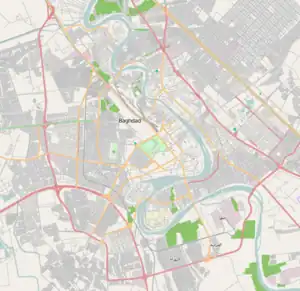Al-Wazeer Mosque
Al-Wazeer Mosque (Arabic: جامع الوزير, romanized: Jami' al-Wazir) is an old mosque in Baghdad, Iraq, which is considered a cultural heritage. The mosque was built by the Wazir of Baghdad Hassan Pasha in 1599 during the Ottoman era. Later the mosque witnessed several renovation and restoration works. The main characteristic of the mosque is its Ottoman architectural style.[1] It is located in al-Rusafa district behind the Souk al-Sarai, near the riverbank of the Tigris River. The mosque contains prayer space for over more than 400 worshippers. On the left side of the mosque, there is a round-shaped minaret. The attached garden extends to the riverbank of the Tigris river.[2]
| Al-Wazeer Mosque | |
|---|---|
Arabic: جامع الوزير | |
 | |
| Religion | |
| Affiliation | Islam |
| Rite | Sunni Islam |
| Ecclesiastical or organisational status | Mosque |
| Status | Active |
| Location | |
| Location | Al-Rusafa, Baghdad, Iraq |
 Location in Baghdad, Iraq | |
| Geographic coordinates | 33°20′21″N 44°23′19″E |
| Architecture | |
| Type | mosque |
| Style | Ottoman architecture |
| Specifications | |
| Capacity | 400 worshipers |
| Minaret(s) | 1 |
The area in which the mosque is located in, as well as al-Wazeer Mosque itself, are a part of a tentative UNESCO World Heritage Site.[1]
Historical background
Construction on the mosque first began in 1599 under the supervision of Hassan Pasha who governed Baghdad under the Ottoman Empire between 1594 and 1603.[1] Later in 1604, a famous café was built next to the mosque that overlooked the Tigris River and was named the "Hassan Pasha Café."[3] In 1686, an army officer named "Ahmed Agha" was ordered to rebuild the western side of the mosque. He also added a high dome and expanded it.[1]
The mosque was visited by British traveler and journalist James Silk Buckingham in 1816 during his visit to Baghdad and noted the mosque for its "fine dome and lofty minaret."[4]
Architectural description

Al-Wazeer Mosque is located in the heart of the Souk al-Sarai, near al-Mutanabbi Street. The mosque contains a traditional Iraqi minaret in addition to a dome covered with glazed tiles and marble. Inside, there are decorations consisting of stalactites and muqarnas decorated with Quranic verses and floral motifs. The entrance to the Mosque is a wooden door surrounded by yellow bricks and glazed with blue. Once entering the mosque, a wide courtyard that reaches more than 1000 square meters is found in the company with walls decorated with motifs and writings.[5]
The mosque was built on an area of 1000 square meters and it has two places for the summer prayer, which can accommodate about 330 prayers and also the winter prayer room, which can accommodate 500 prayers. The mosque is considered one of the most beautiful mosques in Baghdad and it generated a folktale about its construction following a shipwreck on the bank of the Tigris River that set its location.[5]
Gallery
 The Mosque's interior.
The Mosque's interior.%252C_Baghdad_-_1930.jpg.webp) The Mosque's Minaret as seen on the left next to al-Asifyah Mosque, 1930.
The Mosque's Minaret as seen on the left next to al-Asifyah Mosque, 1930. Al-Wazeer Mosque next to al-Asifyah Mosque, 2017.
Al-Wazeer Mosque next to al-Asifyah Mosque, 2017. The mosque as of 2023.
The mosque as of 2023.
References
- Historical Features of the Tigris River in Baghdad Rusafa, which extends from the school Al-Mustansiriya to the Abbasid Palace. UNESCO. Retrieved January 3, 2018.
- مسجد الوزير. Masajed Iraq. Retrieved January 3, 2018.
- Baghdad cafes, cultural life exchange, 1999
- Buckingham, James Silk (1827). Travels in Mesopotamia. H. Colburn.
- https://tableegh.imamali.net/index.php?id=1471
